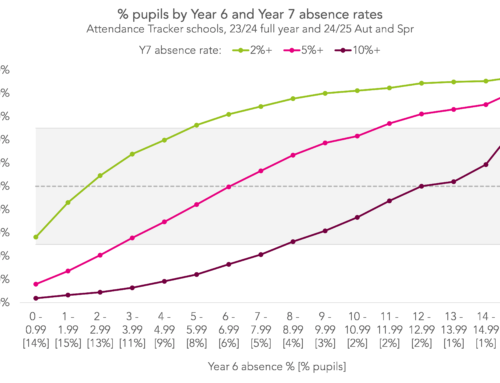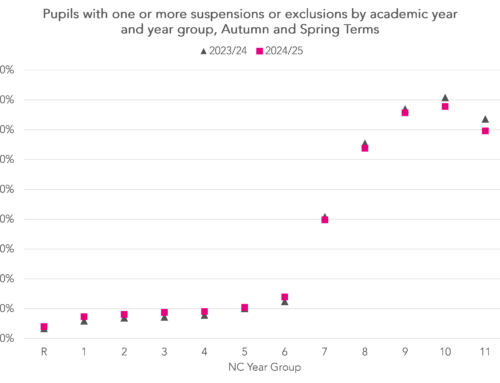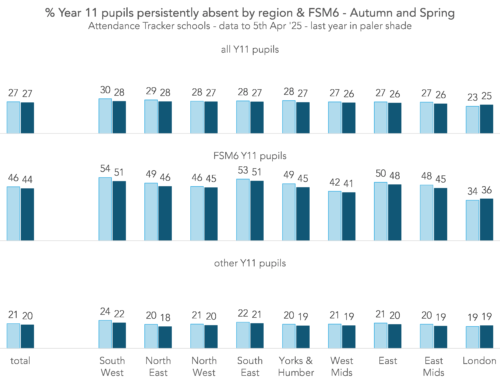A few years ago, an interesting article in the Times Educational Supplement summarised some analysis that showed that there was an increase in absence among disadvantaged pupils on Christmas Jumper Day.
Last week there was another “day” which has tended to feature dressing up – World Book Day – which took place on 1st March.
So did this coincide with a fall in attendance among disadvantaged pupils?
And what about Christmas Jumper Day this year? And Children in Need Day?
Data
To look at this, we’ll use data supplied by 7,500 primary schools using Attendance Tracker this term.
World Book Day took place on the same day as industrial action in the East Midlands, West Midlands and the East of England. Consequently, we exclude schools in those regions from the analysis.
We summarise attendance on the 1st March and compare it to previous Wednesdays. As we have shown previously, Wednesday is the day when attendance tends to be highest.
Due to the staggered nature of half-term, we combine data for 15th February and 22nd February.
World Book Day
Compared to the previous Wednesday, there was a slight increase in absence among disadvantaged pupils in primary schools on World Book Day from 6.9 to 7.1%. Absence among other pupils remained unchanged at 4.1%.
Is this evidence of a World Book Day effect on the absence of disadvantaged pupils? Possibly not. Larger differences in absence between disadvantaged and non-disadvantaged pupils can be seen on 18th January and 25th January [1].
Christmas Jumper Day
Christmas Jumper Day (CJD) took place last year on Thursday 9th December.
In the chart below, we show absence compared to previous Thursdays. This time we include schools in all regions.
However, absence increased markedly towards the end of term (not just on CJD), mostly as a result of increased illness as we showed here.
Absence among both disadvantaged and non-disadvantaged pupils on Thursdays had been increasing at a linear trend prior to the 1st December, increasing by 1.2 percentage points per week among disadvantaged pupils and 0.9 percentage points per week among other pupils.
Ignoring 1st December, absence rates for 9th December were slightly higher than those trends for both groups.
Children in Need Day
Children in Need Day took place on Friday 18th November.
Absence tends to be higher on Fridays compared to the rest of the week.
In the chart below, we compare attendance on Fridays to the rest of the week. We’ve left out the two weeks covering half term since some schools have a two-week break.
The chart shows a familiar drop in absence following a break. Absence was lower on the 4th November, the Friday after most schools had returned from half-term.
For each week, the difference in absence rates between disadvantaged pupils and other pupils was between 3.5 and 3.6 percentage points. It was slightly wider at 3.8 percentage points on 11th November, the week before Children in Need Day.
Aspire Attendance Tracker
Schools can track, analyse and compare their attendance data against 1,000s of other FFT schools using Aspire Attendance Tracker.
Log in to Aspire to access Attendance Tracker – log in here.
Not an FFT Aspire user? Learn more here.
Summing up
At the national level at least, we don’t see any particular increase in absence among disadvantaged pupils on World Book Day, Children in Need Day and Christmas Jumper Day this year.
However, it is possible that there may be local effects affecting particular schools (or particular areas) hidden among the national data.
Alternatively, it could mean that schools are handling these days sensitively, with fewer expectations around dressing up and fund-raising that might otherwise lead to increased absence for some disadvantaged pupils.
[1] 1st February not shown due to national industrial action.
Want to stay up-to-date with the latest research from FFT Education Datalab? Sign up to Datalab’s mailing list to get notifications about new blogposts, or to receive the team’s half-termly newsletter.









Some schools chose to do World Book Day on a different day due to strike action therefore this may not be a representative picture.